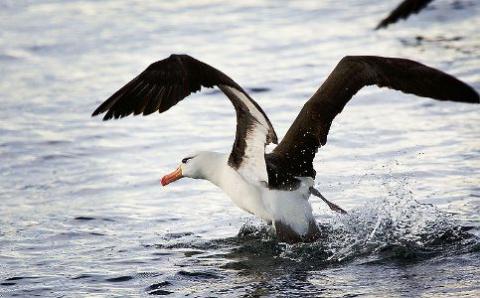
The Endangered black-browed albatross is threatened throughout its range by commercial fisheries bycatch, primarily from longline vessels. Its vulnerability is due to the fact that, like other albatross species, the black-browed albatross is attracted to the easy food source provided by baited longline hooks, and consequently become hooked and drowned (Reid & Sullivan 2004). Black-browed albatross also forage in the continental shelf-slope region, leading to increased seabird-fishery encounters, as this is an areas frequented by longline and trawl vessels (Gales 1998).
Longline bycatch is the principal cause of a global decline in albatross populations, including that of the black-browed albatross (Gales 1998). The species is the most common bycatch species in many longline fleets, including those fishing for tuna off southern Africa, for swordfish off Chile, and for Argentine toothfish and kingclip on the Patagonia shelf (Murray et al 1993; Gales et al 1998; Ryan & Boix-Hinzen 1998; Schiavini et al 1998; Stagi et al 1998; Ryan et al 2002; Reid & Sullivan 2004; Bugoni et al 2008). A significant decrease in black-browed albatross populations has been observed at the Falkland Islands, home to 80% of breeding pairs (Gales 1998); from 1995-2000, this population declined by around 85,000 pairs (Huin 2001). Over the past 20 years, it is estimated that this same population has declined by 25% (Gales 1998; Huin 2001, 2002; IUCN 2002).
Trawl fishery mortality also occurs, mainly on the Patagonian shelf and off the South African Coast, where an estimated 5,000 black-browed albatross are killed annually in the deepwater hake fishery (Watkins et al 2008).
Mitigation methods include the use of technologies such as tori (bird-scaring) lines, acoustic scaring devices, decreasing bait visibility, and line weighting (Brothers 1995; Cherel et al 1996; Lokkeborg 1998; Agnew et al 2000; Boggs 2001). Other methods, such as night-set lines and time-area closures (Ashford & Croxall 1998), incorporate temporal and spatial variability. Previously, these strategies have been used in conjunction, and it remains to be seen if one employed alone will prove effective (Reid & Sullivan 2004). It has been shown, however, that an increase in the number of tori lines used is linked to a decrease in black-browed albatross mortality, including wind speed, wind direction, length of daylight period, season, area, black-browed albatross abundance, and number of tori lines (Reid & Sullivan 2004); it is thus important to consider a full spectrum of factors when developing conservation efforts related to this species.
The black-browed albatross is protected internationally under the Agreement on the Conservation of Albatross and Petrels (ACAP 2012).
References
Agreement on the Conservation of Albatross and Petrels (ACAP). 2012. Agreement on the conservation of albatross and petrels, amended by the fourth session of the meeting of the parties. ACAP, Lima, Peru.
Agnew, DJ, AD Black, JP Croxall & GB Parkes. 2000. Experimental evaluation of the effectiveness of weighting regimes in reducing seabird bycatch in the longline toothfish fishery around South Georgia. CCAMLR Science 7: 119-131.
Ashford, JR & JP Croxall. 1998. An assessment of CCAMLR measures employed to mitigate seabird mortality in longlining operations for Dissotichus eleginoides around South Georgia. CCAMLR Science 5:217-230.
Boggs, CH. 2001. Deterring albatrosses from contacting baits during swordfish longline sets. In: EF Melvin & JK Parrish (eds), Seabird bycatch: trends, roadblocks, and solutions, pp. 79-91. Alaska Sea Grant College Program, Fairbanks.
Brothers, N. 1995. An investigation into the causes of seabird mortality and solutions to this in the Spanish system of demersal longline fishing for Patagonian toothfish Dissostichus eleginoides in the South Atlantic Ocean. Parks & Wildlife Service, Tasmania.
Bugoni, L, PL Mancini, DS Monteiro, L Nascimento & TS Neves. 2008. Seabird bycatch in the Brazilian pelagic longline fishery and a review of capture rates in the southwestern Atlantic Ocean. Endangered Species Research 5(2/3): 137-147.
Cherel, Y, H Weimerskirch & G Duhamel. 1996. Interactions between longline vessels and seabirds in Kerguelen waters and a method to reduce seabird mortality. Biological Conservation 75:63-70.
Gales, R. 1998. Albatross populations: status and threats. In: G Robertson & R Gales (eds), Albatross biology and conservation. pp. 20-45. Surrey Beatty & Sons, Chipping Norton, Australia.
Gales, R, N Brothers & T Reid. 1998. Seabird mortality in the Japanese longline tuna fishery around Australia, 1988-1995.Biological Conservation 86: 37-56.
Huin, N. 2001. Census of the black-browed albatross population of the Falkland Islands 2000/2001. Falklands Conservation, Stanley, Falkland Islands.
Huin, N. 2002. Foraging distribution of the black-browed albatross, Thalassarche melanophrys, breeding in the Falkland Islands. Aquatic Conservation: Marine & Freshwater Ecosystems 12:89-99.
IUCN. 2002. 2002 red list of threatened species. IUCN, Gland, Switzerland. http://www.redlist.org
Lokkeborg, S. 1998. Seabird by-catch and bait loss in long-lining using different setting methods. ICES Journal of Marine Science 54: 145-149.
Murray, TE, JA Bartle, SR Kalish & PR Taylor. 1993. Incidental capture of seabirds by Japanese southern bluefin tuna longline vessels in New Zealand waters, 1988-1992. Bird Conservation International 3:181-210.
Reid, TA & BJ Sullivan. 2004. Longliners, black-browed albatross mortality and bait scavenging in Falkland Island waters: what is the relationship? Polar Biology 27: 131 139.
Ryan, PG & C Boix-Hinzen. 1998. Tuna long-line fisheries off Southern Africa: the needs to limit seabird bycatch. South African Journal of Science 94: 179-182.
Ryan, PG, DG Keith & M Kroese. 2002. Seabird bycatch by tuna longline fisheries off Southern Africa, 1998-2000. South African Journal of Marine Science 24: 103.
Schiavini, A, E Frere, P Gandini, N Garcia & E Crespo. 1998. Albatross-fisheries interactions in Patagonian shelf waters. In: G Robertson & R Gales (eds), Albatross biology & conservation, pp. 208-213. Surrey Beatty & Sons, Chipping Norton, Australia.
Stagi, R Vaz-Ferreira, Y Marin & L Joseph. 1998. The conservation of albatrosses in Uruguayan waters. In: G Robertson & R Gales (eds), Albatross biology & conservation, pp 220-224. Surrey Beatty & Sons, Chipping Norton, Australia.
Watkins, BP, SL Petersen & PG Ryan. 2008. Interactions between seabirds and deep-water hake trawl gear: an assessment of impacts in South African waters. Animal Conservation 11(4): 247-254.
